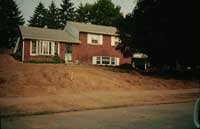Watering Problem Areas
Watering Compacted Soil
If you have a very compacted soil, or if it is clay with very little organic content, then your watering system may provide water faster than the soil can absorb it. If so, to avoid wasteful runoff, water in steps. Water until it begins to puddle. Turn off the system. Wait 15 minutes to a half an hour and then water some more until puddling occurs again. Lawn areas that are moist, firm and have no visible puddles are ready for a repeat irrigation cycle. Areas that are soft and produce squishy footprints when walked on are not ready for more irrigation. When they are ready, water a second time to make sure the lawn gets enough water overall.
Watering Lawns with Thatch
Thatch, the layer of accumulated dead surface roots and debris on the soil around grass plants, is somewhat hydrophobic. It tends to repel water, so it prevents water from passing through it into the soil. The result is uneven moisture over the entire lawn. To counteract this effect, use a wetting agent, called a "surfactant" when watering a heavily thatched lawn.
A mild dishwashing liquid or a product specifically designed for this purpose available at garden centers makes thatch able to absorb the water and pass it through to the soil. Spray it on the lawn with a hose end sprayer, about half water and half soap or follow the directions on the labels of commercial surfactants. The best way to solve this problem, of course, is to get rid of the thatch.
Watering Newly Seeded Lawns
Watering is critical to the success of new lawns. Homeowners almost always fail to water newly planted grass seed sufficiently. To have its best chance for germination, grass seed needs to be kept moist all the time!
Missing only one day of watering can reduce germination by 30%. Missing two days reduces it by 50%. It is essential to keep the top ¼ to ½ inch of soil from drying out for the first two to three weeks of a new lawn. While seed is germinating, a light sprinkle from the hose will do the job. When sprouts appear, water a bit more generously.
Watering Newly Sodded Lawns
For new sod, watering is just as important. Once it is installed, do not permit it to dry out at all. The sod itself must be thoroughly wet throughout its roots and soil, and the soil bed where it is laid must be wet down another inch or two. Watch out for edges between pieces of sod and along the sidewalks and driveways where the water evaporates more quickly. They dry out first. In the absence of rain, water regularly for at least 6 weeks or until the sod roots have penetrated into the soil bed and become established.
Dealing with Drought and Watering Restrictions
When drought conditions exist and local restrictions to conserve water are in effect, use of water for irrigating lawns is high on the list of non-essential uses. Often water restrictions allow only hand watering in the yard. You can drastically reduce the use of water without losing the entire lawn.
 Northern grasses go dormant and turn brown in hot and dry weather, a survival mechanism that served their ancestors in arid regions of the world. Dormancy serves grass essentially the same way in residential landscapes. Since it does not guarantee that a lawn will fully recover from total water deprivation during a drought period, try to provide an inch to an inch and a half of water every two to three weeks during these times. The grass may not noticeably green up, but this should be sufficient to hydrate the lower plant portions and increase the odds of recovery once adequate moisture is available. Then a dormant lawn takes about three to four weeks to recover and generate new green blades replace the dried, brown ones.
Northern grasses go dormant and turn brown in hot and dry weather, a survival mechanism that served their ancestors in arid regions of the world. Dormancy serves grass essentially the same way in residential landscapes. Since it does not guarantee that a lawn will fully recover from total water deprivation during a drought period, try to provide an inch to an inch and a half of water every two to three weeks during these times. The grass may not noticeably green up, but this should be sufficient to hydrate the lower plant portions and increase the odds of recovery once adequate moisture is available. Then a dormant lawn takes about three to four weeks to recover and generate new green blades replace the dried, brown ones.
During extended drought, try not to walk on the lawn at all, especially after watering. Drought stressed grass will not recover from damage as rapidly as healthy grass. More importantly, wet soils compact to a greater extent than dry soils under even normal foot traffic. If drought is a chronic problem in your area and is anticipated almost every year, adjust your lawn care practices to reflect that reality by fertilizing in the fall only. Change a Kentucky bluegrass lawn to a turftype tall fescue lawn that, once established, is far more drought resistant.
